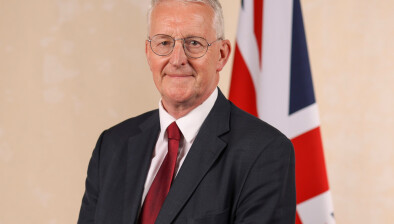NI: High Court: Investigation into the 1973 murder of Daniel Carson ‘flawed and inadequate’
An inquest into the death of Daniel Carson, a young Catholic who was murdered as he left work near the lower Shankill in 1973, has found that the investigation into his death was “flawed and inadequate”.

About this case:
- Judgment:
- Court:High Court
- Judge:Mr Justice Adrian Colton
Finding that there was “compelling and credible evidence” that the gunman was someone identified as S1, the Coroner, Mr Justice Adrian Colton, concluded that there was no evidence of State involvement in the murder or collusion.
Background
On 1 November 1973, Daniel Carson was shot dead as he was driving home from his work in a Warehouse near the lower Shankill in Belfast.
One of Mr Carson’s work colleagues, Witness A, told the police that she recognised the gunman as a person referred to as S1. Witness A told the police that she had known S1 for about five years at the time and claimed that in conversations he had made derogatory comments about Catholics, including “There is one left in your place but he’ll run when he sees the rest running”. Witness A understood S1 to be referring to Mr Carson.
Statements were also provided to the police by three military witnesses who called at the house where S1 was living on the day of the attack after hearing his name being mentioned by members of the public.
S1 was arrested by the police on 5 November 1973 and his house searched, but nothing was found. That evening, Witness A attended the police station fearing that she would be murdered if it was known she named S1. The following day, S1 was released from custody.
No person has ever been charged in relation to Mr Carson’s death, and in June 1974, an inquest into Mr Carson’s death recorded an open verdict.
PSNI Serious Crime Review Team
In 2004, a PSNI Serious Crime Review Team reviewed the case. Their report considered that evidential opportunities had been lost by the army calling at S1’s house without arresting him or liaising with the police. The report also recorded that Witness A had expressed her fear about naming S1, and the report stated that the police were satisfied that she would have been killed and S1 was not charged on that basis.
In September 2004, Witness A had “more than reasonable doubt about her original identification of S1 and later changed her mind about his being involved”. Notwithstanding Witness A’s position, it was recommended that the investigation be referred to a Senior Investigating Officer, and that a report to the DPP would be required.
Historical Enquiries Team
In 2005, the case was forwarded to the Historical Enquiries Team (HET). Between 2006-2010, the HET carried out a review. Witness A maintained her position that she may have been mistaken that it was S1, and also recalled an incident that made her nervous where “an uncle of S1… called her by name and said something like ‘Our S1 is like a big child, he wouldn’t have it in him to hurt anybody’”.
The HET’s initial report stated that Witness A had failed to confirm the identity of the gunman, and commented that actions by the Army immediately after the shooting in all likelihood terminated any realistic chance of finding evidence and a subsequent conviction of the suspect.
It concluded that there were no further avenues of investigation which could be proceeded with by the HET to locate those responsible for Mr Carson’s murder.
Fresh inquest
The Attorney General exercised his powers under section 14(1) of the Coroners Act (Northern Ireland) 1959 to direct a fresh inquest. In doing so, he referred to the limitations of the previous inquest, notably the absence of any consideration of the evidence of Witness A.
The Coroner, Mr Justice Adrian Colton concluded that Daniel Carson was murdered solely because of his religion. He said he was a decent hardworking young man working to support his wife and growing family and in a workplace where he was valued and had many friends, not least Witness A.
Mr Justice Colton said Mr Carson’s “senseless murder” was “a reminder of how sectarianism has disfigured our history”.
On reading Witness A’s initial police statement, Mr Justice Colton said:
“On any reading [Witness A’s statement to the police of 2 November 1973] is an exemplar of a convincing identification statement. It is a statement of someone right at the centre of the event she is describing. Her account is told with clarity. It conveys the horror of the unfolding events and is impressive in its detail. Witness A acted with great bravery and compassion, confronting the gunman and placing herself in danger as she ran towards the deceased’s car. It appears she actually shouted out S1’s name as she did so. What she says about the incident corresponds with the known facts about what happened.”
Mr Justice Colton was satisfied that there was credible and compelling evidence that S1 was the person who shot Mr Carson, and that Witness A “became unwilling to give evidence against S1 because of fear for herself and her family and that this was conveyed to the RUC in the course of the investigation. Further, that she remains in fear and this is why she has resiled from her initial convincing and credible identification”.
Mr Justice Colton concluded that there was no evidence of State involvement, nor any evidence of any collusion between State Agents and the murderer before or after Mr Carson’s death.
Mr Justice Colton was critical of both the actions of the military and the RUC in relation to the investigation of Mr Carson’s death, but considered that there “simply was an insufficient evidential basis” to conclude that the investigators were motivated by sectarian bias. He said the decision not to charge S1 was motivated by their view that Witness A was unwilling to give evidence and that in fact if she did her life and that of her family would be in danger. Mr Justice Colton said that sadly, this was “all to credible a scenario at that time”.
Mr Justice Colton said that the conviction of S1 would not necessarily have been achieved even if the matter had been investigated more thoroughly or properly, and that ultimately, a successful prosecution depended on Witness A’s willingness to give evidence at any trial. He said the entire approach of the RUC was clearly coloured by the assessment that Witness A would not give evidence even though “the recognition/identification was never in doubt”.
- by Seosamh Gráinséir for Irish Legal News








